The supermoon is seen rising behind the Soyuz rocket at the Baikonur Cosmodrome launch pad in Kazakhstan Monday.
PHOTOGRAPH BY BILL INGALLS, NASA
The supermoon rises behind an eagle sculpture atop LeVeque Tower in Columbus, Ohio, on Sunday.
PHOTOGRAPH BY ADAM CAIRNS, THE COLUMBUS DISPATCH, ASSOCIATED PRESS
The supermoon appears to balance on top of the St. Louis arch.
PHOTOGRAPH BY DAVID CARSON, ST. LOUIS POST-DISPATCH, ASSOCIATED PRESS
A jet flies across the supermoon en route to Heathrow Airport in London.
PHOTOGRAPH BY ADRIAN DENNIS, AFP, GETTY IMAGES
The supermoon rises above apartment buildings in Beijing.
PHOTOGRAPH BY NG HAN GUAN, ASSOCAITED PRESS
The big, bright moon looms behind a Ferris wheel in Hong Kong.
PHOTOGRAPH BY ANTHONY WALLACE, AFP, GETTY IMAGES
The supermoon strikes a visual contrast with the Reunion Tower in downtown Dallas.
PHOTOGRAPH BY TOM FOX, THE DALLAS MORNING NEWS, ASSOCIATED PRESS
A man enjoys the supermoon from his balcony in Madrid.
PHOTOGRAPH BY GERARD JULIEN, AFP, GETTY IMAGES
The moon rises behind the castle of Almodovar in Cordoba, Spain.
PHOTOGRAPH BY MICUEL MORENATII, ASSOCIATED PRESS
Beijing's Forbidden City makes for a stunning place to enjoy the supermoon.
PHOTOGRAPH BY NICOLAS ASFOURI, AFP, GETTY IMAGES
The supermoon rises above the Valley of the Gods near Mexican Hat, Utah.
PHOTOGRAPH BY JIM LO SCALZO, EPA
On November 13 and 14, the world is treated to thebrightest supermoon in 68 years. And the pictures coming in are stunning (see above).
The term supermoon refers to a full moon that coincides with the lunar orb’s closest approach to Earth, or perigee. And the last time it was this close to the Earth was in 1948.
Supermoons tend to look larger and brighter in the sky, offering a rare treat for sky gazers.
The variability is caused by the fact that the moon's orbit around the Earth is egg-shaped and slightly irregular, making for times when it is closer or farther away from us. At its closest point this cycle, at 6:21 a.m. ET (11:23 UT) on November 14, the moon will be just 221,524 miles from Earth, as measured from the center of both bodies.
The full moon won’t get this close to us again until November 25, 2034. And the closest full moon to Earth this century will occur on December 6, 2052, when our celestial neighbor will be just 221,472 miles away.
(NATIONAL GEOGRAPHIC)
 简体中文
简体中文

